
In retail, domes can provide high security with or without being conspicuous.
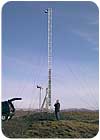
Domes can be used for a birds-eye view with wires to stabilize the image.
“The No. 1 thing they should look for is visibility,” recommends Jake Lahmann, vice president of operations for Supercircuits, Austin, Texas. “What I mean by that is, where is the enclosure going to be located and what is the purpose for it?”
Lahmann classifies enclosures as conspicuous, blending or hidden. This consideration also is important to Nick LaBella, director of marketing for CCTV at ADI, Melville, N.Y.
“In some of these real architectural types of buildings in New York City, the owner of the building or the loss prevention manager is saying, ‘We don’t want to be able to see these cameras — they need to blend in.’”
In these cases, small unobtrusive domes finished to match the building’s interior in white, brass, chrome or copper should be recommended by dealers and integrators.
“Then there are plenty of times where the customer says, ‘I want that dome to be out there and big and as intrusive as possible, because I want everybody to know it’s there,’” LaBella stresses.
In those cases, large domes and housings should be chosen to act as deterrents to crime. Some even feature blinking lights to draw attention to them. In some cases, certain domes or housings are dummies and some have cameras in them.
With some systems, cameras can be moved from one dome or housing to another so customers and employees do not always know where the cameras are. These types of systems are used when illegal activity is suspected in a particular area.
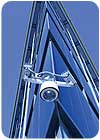
Wide coverage is provided by domes combined with additional instruments.
“They do a concept called bicycling of a particular register,” he continues. “They take a working dome and swap it with a drone. You have to do this within seconds, so being able to swap things out and move them around and have the ability to keep and save the programming without having to redo it is key.
“It depends on the design, but the design should be something the end user can do themselves by just going up a ladder, doing a simple twist and uninstalling the dome,” Cremins emphasizes. “When you’re choosing a dome, installation is really key. You don’t want to have anything that is going to take a long time and prevent anyone from doing this type of swapout.”
Another consideration in dome application is whether the camera inside can be seen. If the user does not want the position of the camera to be visible, smoked or reflective domes should be recommended. But the amount of light getting to the camera should not be too adversely affected by this.
“The ideal product gives you that covert factor but doesn’t allow you to sacrifice picture quality,” Cremins stresses. “You need to get the best possible picture for any type of surveillance application. That’s what it’s all about.”
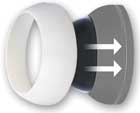
The cover can be switched or painted to match a particular décor. It saves dealers from stocking multiple colors of domes.
SELECT THE RIGHT RATING
Ratings of the National Electrical Manufacturers Association (NEMA) and IP ratings are used to describe the resistance of domes and housings to solid objects like dust and liquids. For example, in an IP rating, which is used internationally, the first number indicates resistance to solid objects and the second number indicates liquid resistance.Dealers and integrators should always select enclosures that have the appropriate IP or NEMA rating for the use intended without overspecifying a more expensive product than is necessary.
A one-line description is used for IP ratings, points out Ilan Gershon, product development manager of cameras for Digimerge Technologies Inc., Markham, Ontario, Canada.
“With end user customers or dealers, in my opinion, the IP rating is the way to go, even though the NEMA rating is a little more detailed,” Gershon asserts. “If you’re really setting a spec, the NEMA rating standard is probably the way to go.”
Dealers/integrators should be sure when selecting domes from different companies that they can be integrated into a system.
“The dome has to be able to talk to not just a controller from one company, but from multiple companies,” Cremins points out. “And because domes these days are so fully featured, it’s not just the ability to control the PTZ you should have, but the ability to set and call preset patterns and be able to tap into the domes’ internal settings, like privacy zones.”
“The best way is to go with the housing that is supplied by the supplier of the camera,” Gershon maintains. “The main reason for that is if anything goes wrong or it doesn’t fit properly or scratches the lens, you have the warranty.”
Dealers and integrators should select domes and housings with continuous rubber gaskets around them rather than pieces of foam, recommends Scott Watson, vice president of Videotec Security Inc., Totowa, N.J.
“Other manufacturers use foam — foam works great the first couple of times, but if you open and close the housing a number of times, that foam starts to deteriorate and the seal gets broken,” Watson maintains. “The quality issue is really the idea that once it’s up, never having to go back and redo it.”
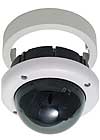
The harder it is to see the camera inside a dome, the darker the view the camera sees.
“As you zoom out, the focal point goes behind the cage, and the bars of the cage disappear, so you can see through them,” Cremins explains. “It’s an optical trick, but in the end it does the job.”
As domes and housings are being used more frequently in residential and sophisticated commercial designs, matching the finish on them to the building’s décor is gaining importance. One way of maintaining versatility in finishes without increasing inventory is to use domes with snap-on or paintable covers.
Multiple voltages for domes also are helpful so they operate on either 12 or 24 VAC. When selecting domes for outdoor applications that will be facing the sun at certain times of day, be sure to include a sun shield. It lowers the temperature inside the dome by 10 to 15 degrees Fahrenheit and also can block out lens flare from a rising or setting sun.
If a camera in a dome or housing with a sun shield also uses infrared lights, be sure the sun shield is not so far forward that the infrared light reflects back from the sun shield into the lens, suggests Gary Perlin, vice president of video products, Speco Technologies, Amityville, N.Y.
In hot or cold environments, specify blowers or heaters and be sure to supply enough electricity to operate them.
Another consideration in outdoor housings is to choose fasteners that are tamperproof, that do not fall out when unscrewed and that are stainless steel or anodized.
“You have this beautiful beige aluminum housing, but if your hinges aren’t anodized or stainless steel, they will rust within the week,” Perlin emphasizes. “Make sure you’re getting the right hardware that will hold up.” He estimates it only costs $2 or $3 more.
Selecting a housing large enough for a zoom lens with a wide focal range is important, but the widest angle of the range cannot be forgotten either, points out Dan Scroggins, product marketing manager for positioning systems, Pelco, Clovis, Calif.
“They don’t compensate for that wide-angle view, so when the camera goes to full wide, you’ll see the inside of the enclosure,” Scroggins points out. “That happens on a frequent basis. They should have calculated the minimum and maximum horizontal and vertical fields of view.”

Sidebar: Pressurization Resists Water
For underwater installations or environments where dust or moisture is a serious consideration, domes pressurized with nitrogen gas are the best product to recommend to customers. However, they require extra maintenance to repressurize the gas in the domes periodically when their alarms indicate.“The polycarbonate used for the bubble allows nitrogen molecules to escape — it actually permeates through the polycarbonate bubble,” points out Dan Scroggins, product marketing manager for positioning systems, Pelco, Clovis, Calif. “It’s just a fact of life — there’s nothing you can do to change that. The only way you could resolve that is to manufacture it out of glass, in which case it would not be durable.”
Pressurized domes also should be recommended for restaurants where high-pressure hoses are used to clean up kitchens. They also should be specified for marine applications.
“A lot of people buy these and put them on their boats,” reports Gary Perlin, vice president of video products, Speco Technologies, Amityville, N.Y. “We have cameras geared toward the marine market that are meant to go underwater. If you’re out there and your boat’s propeller jams, you throw the camera overboard or you go overboard to see what is jamming it.”
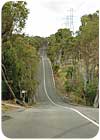
Sidebar: Look Above the Horizontal
In some installations, the ability of a dome to look above the horizontal may be required due to hilly terrain and should be specified by dealer and systems integrators, such as when a pole-mounted dome is monitoring traffic.“If the hill is high enough, and the pole is too short, you could miss the top of the hill, so a PTZ dome that can look above the horizontal can help in situations like that,” points out Douglas Ringer, global product manager for PTZ domes, Honeywell Video Systems, Louisville, Ky. “It’s usually a trade-off when you design the product.
“In order to benefit from seeing above the horizontal, the camera should be slightly lower in the dome,” he explains. “This gives you a slightly larger, lower dome than if you didn’t.”


